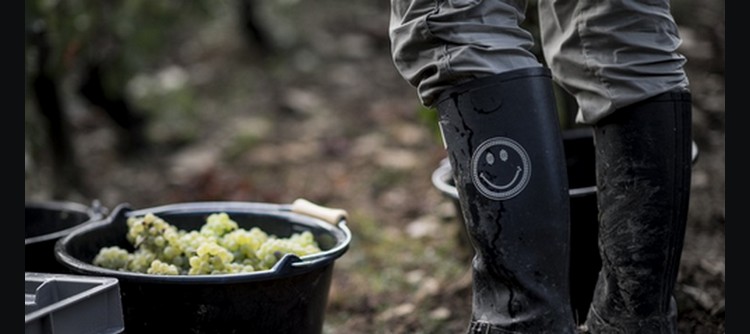The 2021 vintage was a challenge for winegrowers right up until the very last day. From the frost in April, made worse by a very early start to the winegrowing season, right through to the September harvest, it was characterized by some brutal shifts in the weather. Winegrowers had to be extremely reactive and attentive. The only moment of respite came with flowering, which was ideal for fruit formation, and véraison, which was accompanied by sunshine from mid-August. In the end, hard work was rewarded with success, low volumes aside. Indeed, while conveying his hope that the 2022 vintage will offer an easier ride, François Labet, co-president of the BIVB confirmed his opinion that, “Small is beautiful!”
Aside from the low yields due to frost, and hail in June in certain parts of the Mâconnais, the grapes were sorted meticulously, both in the vines and in the winery. The capricious weather in July and early August encouraged the development of pockets of disease, but these were fortunately contained thanks to the efforts of the winemakers and the return of dry weather later in August.
The general opinion is that the 2021 is an interesting vintage to work with because it requires great technical skill and vinification must be very precise. Although fermentation was rapid, one had to pay a great deal of attention to the extraction of tannins and color for the reds, and to the aromatic balance of the whites.
The impression from the first tastings is that the musts have good aromatic potential and the sugar-acidity ratio suggests a style appreciated by fans of Bourgogne wines.
Click on the image to discover the 2021 vintage in video presented by Isabelle Meunier
The weather that shaped the 2021 vintage
After three years of early harvests that began in August, the 2021 vintage marked a return to more traditional dates for Bourgogne. Picking started on 18 September for still wines. The low yields resulting from the frost in April meant that harvesting took much less time than normal, and all grapes were picked by early October. With unpredictable weather throughout the summer, with some brutal shifts in temperature and localized rain, winegrowers had to work hard right through to the end.
An historic frost, both in terms of area and intensity The winter of 2020-2021 saw alternating periods of mild and cold weather. But overall, it was milder and wetter than the average over 1994-2020 (see charts below). The weather cooled sharply in mid-March before warming significantly to more summery temperatures during Easter week from 29 March to 3 April.
This suddenly stimulated the growth cycle of the vines, and in the space of a few days in early April, some plots – mainly Chardonnay – reached the mid-budburst stage. This was
followed by a brutal change on the night of 4 April. A huge mass of polar air descended on the region, bringing thick frost, between 6-9 April in particular. This affected the entire
winegrowing region and the fragile buds that had just emerged from their cotton wool cocoons. This would have a huge impact on the future yield, but it was impossible to estimate
the loss as the damage was unevenly spread across the vines.
The vines were shaken by this episode and took time to return to growth, all the more so as the weather turned wetter and colder than usual. And there was no surprise that the secondary buds offered very little in terms of fruit. Fortunately, the temperature returned to normal in early June, and rose suddenly from 8 June onwards, bringing much warmer weather than usual.
Fast and favorable flowering
Flowering then took place extremely quickly, thanks to the hot and dry weather that provided ideal conditions for pollination and fruit set. The mid-flowering date (when 50% of flowers have blossomed) was close to that observed in 2019: Between 13 June for the Chardonnay in the Mâconnais, and 18 June for the Pinot Noir on the Côte de Nuits. Although the pace was fast, fruiting was disparate across the region depending on frost damage.
The high temperatures continued, encouraging very quick growth which meant that the 2021 vintage was able to make up some of the time lost in April and May.
A cool start to the summer
From the end of June to the beginning of August, the rain set in. The vines grew very quickly, which required hard work on the part of winegrowers, with the raising of the vines proving to be particularly time-consuming.
They also had to tackle the threat of disease which was making an appearance.
They finally got some respite mid-August, with the return of a long spell of dry weather. The mid-véraison stage, when the grapes change color, occurred around mid-August. The dry weather and a northerly wind allowed the grapes to ripen gradually.
Picking started with the Pinot Noir
This interlude was short-lived. The end of August marked the beginning of a period of autumnal weather that continued until the harvest. Winemakers had to monitor the grapes’ aromatic and phenolic maturity on a daily basis, while taking into account the weather in order to harvest at the desired ripeness.
Harvesting of grapes for Crémant de Bourgogne wines began on 8 September in the southern part of Bourgogne, with picking of those for still wines beginning around 18 September. Unusually, the red grape varieties of Pinot Noir, Gamay, and César were the most advanced in terms of maturity, especially the Pinot Noir. Many began their harvests with the reds to capture the aromatic maturity of the grapes. The Chardonnay grapes ripened a little later, probably due to the stress caused by the frost, and were thus picked last.
Yields were very mixed across all sectors. Winegrowers had to deal with low volumes, and even some extremely low volumes on those vines most affected by frost and/or hail. Those grapes required drastic sorting both in the vines and upon arrival in the winery.
This press release only offers a general snapshot.
Because each wine and each winemaker is unique, wines need to be tasted individually before being characterized.






